
How to Create the Best Sequences? [With Top 12 Sequence Frameworks from Experts (Part -1)]
Generating enough responses, booking meetings, and building a healthy sales pipeline can be incredibly frustrating.
That’s because your outbound isn’t working.
Okay. So, why aren’t your outbound campaigns working?
Well, there may be several reasons:
❌ Targeting the wrong audience
❌ Lacking a clear value proposition
❌ Delivering a generic, sales-y message
But, it could also be that you don’t have the right cadence. ⏱️
This is where your sequence frameworks come in. They’re like roadmaps designed to guide you through customer engagement, from initial contact to booking meetings and building a strong pipeline.
The good news is, that these frameworks already exist! Sales experts have tried various methods with thousands of prospects and achieved great results.
Replicating and adapting these frameworks to your target audience is much easier than starting from scratch.
So, let’s start with some of the best ‘sequence frameworks’ for you to craft targeted, valuable, and well-timed outreach that gets results!
Top Sequence Frameworks
- JMM Sequence Framework
- The Agoge Sequence Framework
- Flip the Script Sequence Framework
- The 4-email outbound sequence framework
- ‘Find the channel’ sequence framework
- 5 Sprint Sequence Framework
The Justin Michael Method Sequence Framework
This framework is the exact sequence that Justin Michael uses for almost all his clients.
The Triple Touch
The triple touch consists of 1 call, 1 voicemail, and 1 email sent within 2 minutes.
This allows the prospect to choose their preferred channel for replying and helps them become familiar with your name.
Clusters and Bumps
Justin divides this sequence into 3 clusters. Each cluster has a main email addressing the pain point and 2 “bumps” that follow up.
The “bumps” are flexible. They can be follow-up emails, reply bumps, or LinkedIn messages. Basically, you can choose the channel.
Here’s the framework:
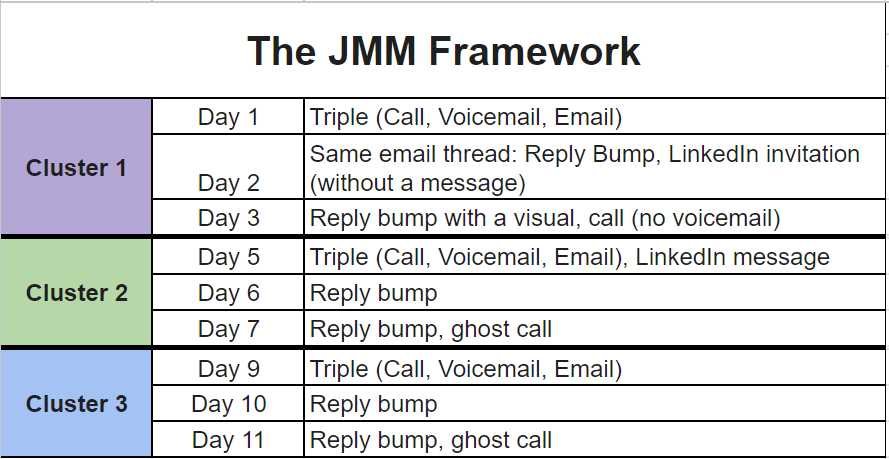
Total of 21 touches in 11 days
- 9 emails
- 3 LinkedIn touches
- 6 calls, with 3 voicemails
The JMM framework works great on sales buyer personas. However, you can consider extending the sequence between the clusters based on your target audience.
Want to check out more? Go to Justin Michael’s LinkedIn post to get message templates for each step of the sequence.
Pros
✅ This ensures high visibility and frequent engagement, keeping the prospect constantly aware of your presence.
✅ Utilizes a mix of emails, LinkedIn touches, and calls, thus increasing the chances of reaching the prospect.
✅ The distribution of touches provides a good balance between different methods of contact, potentially avoiding over-reliance on a single channel.
Cons
❌ The high frequency of touches might overwhelm prospects, which can lead to annoyance or a negative perception of the brand.
❌ Requires significant time and effort to manage the sequence, particularly with the high number of calls and voicemails.
The Agoge Sequence Framework
This sequence was created by Sam Nelson, Founder of the Agoge Prospecting School and former Sales Manager at Outreach.
While working, the grueling training of Spartan warriors called Agoge inspired him.
He believed the Agoge team, if done right, could boost performance, consistency, and fresh ideas for the sales team.
And it worked! His Agoge team crushed their goals, achieved 243% of quota, 100% participation, and became the fastest-growing sales group ever.
So, here’s the sequence that the Agoge team used:

It combines email, phone, and social media touchpoints.
- The opening emails: The first email is crucial. So, you have to personalize the first two sentences to grab attention and show that you’ve researched your customer’s needs and pain points.
- Reply emails: A clever trick is to send follow-up emails simply saying “Checking in!” or “Just seeing if you got this…” so that your first email jumps back to the top of the prospect’s inbox.
- Middle emails: Same strategy as the opening emails except the entire first email is a template and sent automatically.
- Social touches: This can be any channel based on your prospects and doesn’t have to be LinkedIn only.
- Calls: Use the first two lines of the initial email as the opening to your call script. it takes no additional research on your part.
- Break-up email: If someone doesn’t respond, send a final email. The goal here is to be remembered, even if it’s funny or blunt. A reaction is better than silence.
Suggested Read: 10 break-up emails that your prospect can’t resist replying to
Total of 15 touches in 27 business days
- 7 emails📨
- 6 calls, with 2 voicemails first and middle calls
- 2 social touches
Pros
✅ Provides a more measured approach that reduces the risk of overwhelming the prospect.
✅ Offers a comprehensive multi-channel strategy that increases the likelihood of engaging the prospect.
✅ Maintains a persistent yet less aggressive approach, potentially leading to better reception by prospects.
Cons
❌ The reduced number of touches might result in slower momentum and less immediate engagement compared to more frequent sequences.
❌ The extended duration may delay responses and prolong the sales cycle, which could be a drawback in fast-moving industries.
❌ With fewer touchpoints, there may be less opportunity for highly personalized outreach compared to more intensive sequences.
Flip the Script Sequence Framework
This sequence is created by Becc Holland, CEO & Founder at Flip the Script and former SDR at Chorus, G2, and Gong.
This sequence has fewer emails and is heavily focused on personalization. It starts with a LinkedIn research step followed by emails and calls shuffled.
As mentioned before, this sequence uses only 5 emails:
- Emails #1, #3, and #4) are heavily personalized and include a ‘Personalized Premise,’ and should take less than 8 minutes to send (~3.5 min. average)
- The remaining two (Emails #2 and #5) are less personalized and should take less than 5 minutes to send (~45 seconds average)
- You’ll see good results on Emails #1, #2, and #5. According to Becc, Email #5 (the break-up email) has the highest conversion overall.
Cold calls should ideally be around 2 minutes long. Becc recommends using the ‘Personalization Premise’ from the most recent email when speaking with the prospect.
Here’s the overall sequence structure:
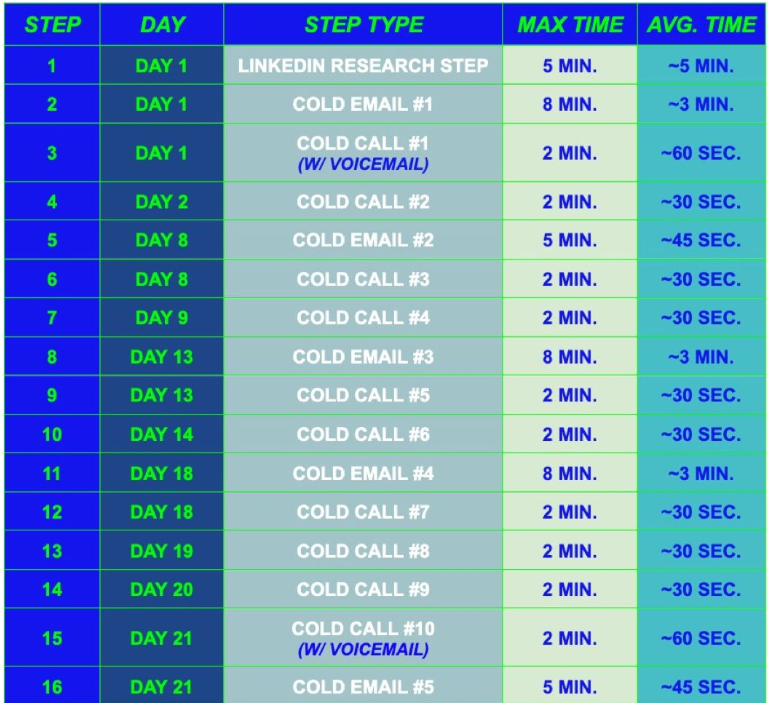
Total of 16 touches in 21 business days
- 1 LinkedIn (research step)
- 5 emails
- 10 calls, with 2 voicemails
Pros
✅ This focuses heavily on personalization, starting with a LinkedIn research step and tailored communications, likely increasing engagement quality.
✅ It reduces the burden on both the sales team and the prospects, aiming for impactful rather than frequent contact.
✅ The use of LinkedIn research and fewer, more strategic touches can lead to higher-quality interactions and better responses.
Cons
❌ There’s a risk of losing momentum and not staying top-of-mind with the prospect.
❌ Poorly executed personalization can negate its benefits and success.
❌ Only one LinkedIn research step limits the social media interaction, potentially missing opportunities for deeper engagement on this platform.
The 4 – Email Outbound Sequence Frameworks
The beauty of this sequence – it has only 4 emails. The rest of the touches are calls and social media.
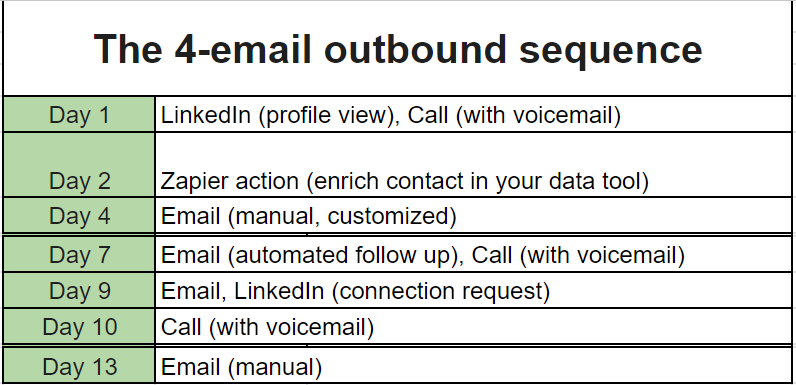
Total of 10 touches over 13 business days
- 4 emails 📧
- 2 LinkedIn
- 1 Zapier
- 3 calls 📞
Pros
✅ Provides a clear communication flow with automated emails, saving you time.
✅ Allows you to build trust and address pain points over multiple touches.
✅Can be A/B tested to optimize open rates and clicks.
Cons
❌ If emails are generic, they might end up in spam folders.
❌ Doesn’t allow for real-time conversation and addressing specific questions.
The ‘Find the channel’ sequence frameworks
Harry Monkhouse, a Sales Adoption Consultant at 6 Sense, created this framework.
Harry says it’s about understanding which channel is the one where you see the highest engagement and gives you the best chance of getting in front of your prospect.
He leverages phone, email, and LinkedIn. He figures out which channel might work depending on the following conditions.
✅If you have a mobile number, follow a heavier call sequence.
✅If they accept your connection request, run a LinkedIn sequence with voice notes, etc.
✅If you see good engagement on your emails then you can double down on email and include video.
So, this isn’t about the message it is about the best ‘channel’ to get my message in front of them.
Here’s the sequence:
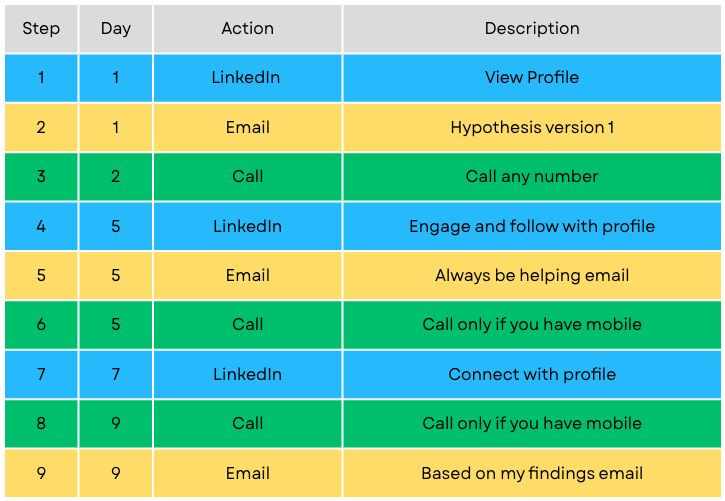
Total of 9 touches over 9 business days
LinkedIn – 3
3 Calls📞
3 Emails 📩
Pros
✅ Focuses on identifying your prospect’s preferred communication channel (email, phone, social media) for better engagement.
✅ Increases the chances of your message getting seen by reaching out through their preferred channel.
✅ Shows you’ve invested time in understanding your prospect.
Cons
❌ Researching individual communication preferences can be time-consuming.
❌ You might not find a clear preference for every prospect.
The 5-sprint sequence frameworks
This is another sequence by Harry Monkhouse.
Here the sequence is broken into 5 sections and Harry calls each of the sections “sprint”.
Each sprint has a slightly different value add and approach but with the view of driving the same outcome which is a meeting booked
✅ Sprint 1 – Show me you know me
This is to show you have researched to allow you to personalize and create relevance in your outreach.
✅ Sprint 2 – Proven Value
Based on the hypothesis you created in sprint 1 link this to a customer story to show how companies have solved this before.
✅ Sprint 3 – Fomo trigger
Using competitor’s names in outreach creates such a high open rate. With this, I am trying to create the fear of missing out … ‘look at why your competitors are winning’.
✅ Sprint 4 – Connections
Try to get your ecosystem whether this is a community or an event. We have data to show that accounts that go to events or are part of a community have a higher win rate.
✅ Sprint 5 – Time to break up
Send a final break-up note but make sure to add them into a nurture cadence which emails them every 3 weeks with some valuable content.
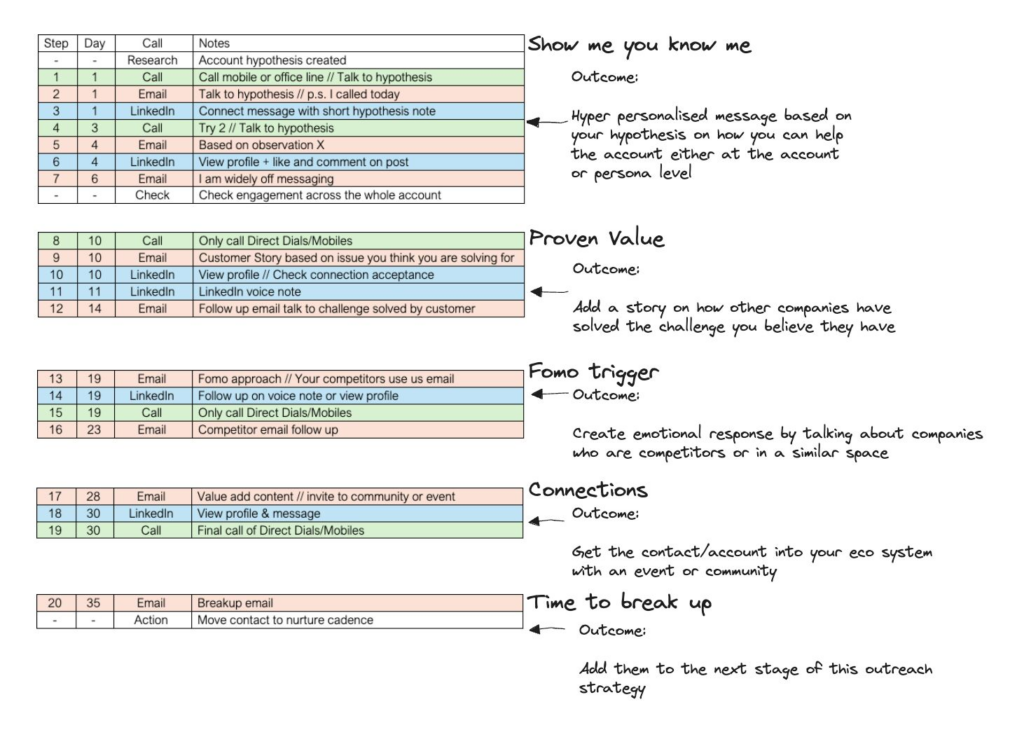
Total of 20 touches over 35 business days
- 6 LinkedIn
- 5 Calls📞
- 9 Emails📨
Pros
✅ Break down complex messages into smaller, more digestible “sprints” that focus on specific actions.
✅ Regular touches with valuable content keep your prospect interested.
✅ Focuses on educating and offering solutions before directly asking for a sale.
Cons
❌ Five touches might feel excessive for some prospects, leading to unsubscribing or disinterest.
❌ Creating targeted and valuable content for each sprint can require significant planning.
🤔 Do these sequence frameworks work?
Yes, but they’re not magic bullets. Their effectiveness depends on several factors.
Quality of Implementation: Following the framework steps diligently and customizing them for your specific audience is crucial.
Target Buyer Persona: Understanding your ideal customer profile helps you choose a framework that aligns with their needs and expectations.
Market Conditions: Some frameworks may be more successful depending on the current market trends and industry dynamics.
These frameworks worked for sales teams because they were customized to their specific needs, which is why they were successful.
Remember to optimize these sequences for the best results!
Use data insights to identify what’s working and what needs improvement. Don’t be afraid to experiment and adapt the framework to your specific needs.